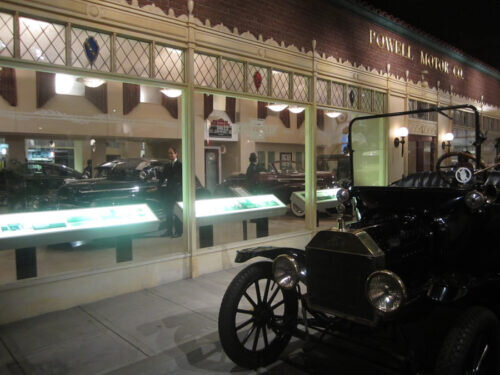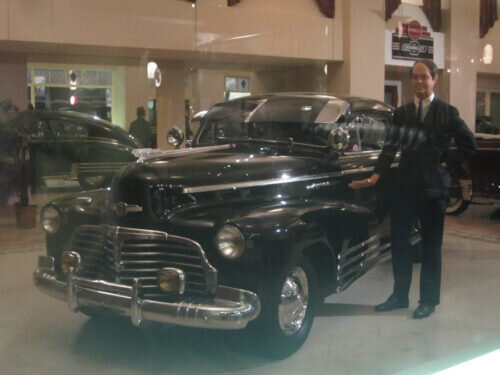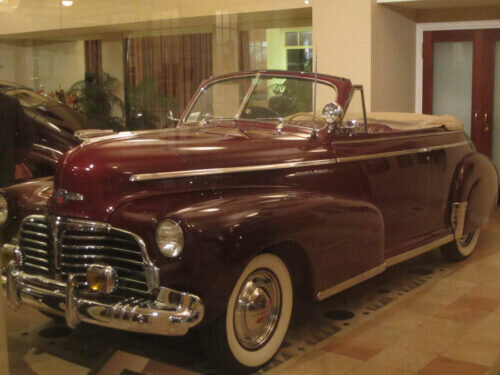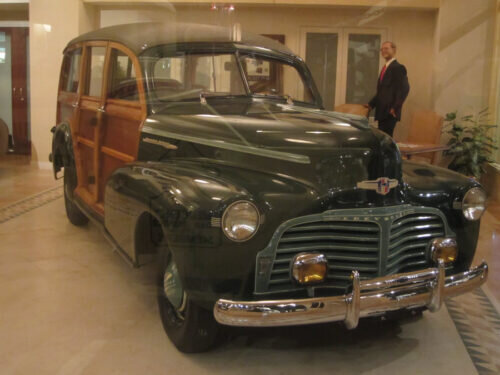Showroom Ready: The '42 Chevy
While stopping by to see the Pickups exhibit at the Petersen Automotive Museum, we took some time to enjoy their Street Scene. Among the many fascinating features of this Street Scene is the Powell Motor Co., fashioned after a period-perfect dealer's showroom. The Petersen regularly rotates the cars on display in the showroom, and this time, this "dealership" played host to a line of 1942 Chevrolets. These happen to be the only vehicles at the Petersen behind glass, so bear with us as you'll see a few ghostly reflections in our coverage of the showroom...
The Petersen regularly rotates the cars on display in the showroom, and this time, this "dealership" played host to a line of 1942 Chevrolets. These happen to be the only vehicles at the Petersen behind glass, so bear with us as you'll see a few ghostly reflections in our coverage of the showroom... "This '42 Chevrolet Fleetline Aerosedan is in incredible original unrestored condition. New to the Chevrolet model line, the sleek Fleetline Aerosedan embodied the fastback styling that swept the industry after World War II. Available equipment included a signal seeking radio, fender skirts, bumper guards, windshield visor, and a cigar lighter.Interiors were upholstered in 'Fleetweave' broadcloth and were carefully detailed to help distinguish the new model from its less aesthetically advanced counterparts. All 1942 Chevrolets were powered by an overhead valve, 90-horsepower 'Victory Six' coupled to a three-speed manual transmission.
"This '42 Chevrolet Fleetline Aerosedan is in incredible original unrestored condition. New to the Chevrolet model line, the sleek Fleetline Aerosedan embodied the fastback styling that swept the industry after World War II. Available equipment included a signal seeking radio, fender skirts, bumper guards, windshield visor, and a cigar lighter.Interiors were upholstered in 'Fleetweave' broadcloth and were carefully detailed to help distinguish the new model from its less aesthetically advanced counterparts. All 1942 Chevrolets were powered by an overhead valve, 90-horsepower 'Victory Six' coupled to a three-speed manual transmission. The 1942 Special Deluxe Convertible was priced at a reasonable $1,080, but a mere 1,182 were built because production was suspended in February 1942 due to wartime materials shortages anticipated by the federal government. Unlike 1941 Chevrolet convertibles, the 1942 models had roll down rear quarter windows that made it possible for rear seat passengers to see out of the car with the top up. Other design updates included fenders that extended info the front doors and a full-width grille with heavy cross bars that predicted the postwar trend toward bolder, more aggressive frontal styling.
The 1942 Special Deluxe Convertible was priced at a reasonable $1,080, but a mere 1,182 were built because production was suspended in February 1942 due to wartime materials shortages anticipated by the federal government. Unlike 1941 Chevrolet convertibles, the 1942 models had roll down rear quarter windows that made it possible for rear seat passengers to see out of the car with the top up. Other design updates included fenders that extended info the front doors and a full-width grille with heavy cross bars that predicted the postwar trend toward bolder, more aggressive frontal styling. Soon after the United States entered World War II during December 1941, the federal government decreed that the use of strategic materials such as chrome, copper, nickel, and stainless steel would be reserved almost entirely for military purposes and could no longer be used on automobile bright trim. As a result, all vehicles produced by domestic manufacturers after January 1, 1942 were fitted with grilles, insignia, hubcaps, side trim, and other adornments coated in baked enamel for visual appeal and to protect the base metals from rust and corrosion.
Soon after the United States entered World War II during December 1941, the federal government decreed that the use of strategic materials such as chrome, copper, nickel, and stainless steel would be reserved almost entirely for military purposes and could no longer be used on automobile bright trim. As a result, all vehicles produced by domestic manufacturers after January 1, 1942 were fitted with grilles, insignia, hubcaps, side trim, and other adornments coated in baked enamel for visual appeal and to protect the base metals from rust and corrosion. Trim pieces already chromed or made of stainless steel had to be painted so that no make would have an unfair sales advantage. The trim colors were chosen to harmonize with the main body color and most of the trim was decoratively pinstriped for added effect. Known as 'blackout specials', these vehicles were built only through early February then stored and later sold to high priority customers through a rationing program beginning March 9. Although appreciated today, the bland look of the blackout specials was not embraced by a large majority of postwar used car buyers and most were quickly consigned to junk yards and scrap heaps."Blackout specials of any make are rare, and we have yet to see one at a car show in all the years we've been attending them. While unpopular in their day, as they served as a harsh reminder of wartime rationing, they are now prized among collectors. Born out of an unpleasant necessity, the blackout specials stand out today with their own unique and timeless beauty.
Trim pieces already chromed or made of stainless steel had to be painted so that no make would have an unfair sales advantage. The trim colors were chosen to harmonize with the main body color and most of the trim was decoratively pinstriped for added effect. Known as 'blackout specials', these vehicles were built only through early February then stored and later sold to high priority customers through a rationing program beginning March 9. Although appreciated today, the bland look of the blackout specials was not embraced by a large majority of postwar used car buyers and most were quickly consigned to junk yards and scrap heaps."Blackout specials of any make are rare, and we have yet to see one at a car show in all the years we've been attending them. While unpopular in their day, as they served as a harsh reminder of wartime rationing, they are now prized among collectors. Born out of an unpleasant necessity, the blackout specials stand out today with their own unique and timeless beauty.
